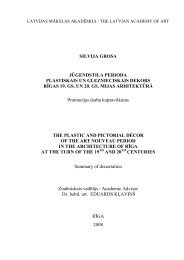Institute of Art History of the Latvian Academy of Art Anna Ancāne ...
Institute of Art History of the Latvian Academy of Art Anna Ancāne ...
Institute of Art History of the Latvian Academy of Art Anna Ancāne ...
Create successful ePaper yourself
Turn your PDF publications into a flip-book with our unique Google optimized e-Paper software.
An important manifestation <strong>of</strong> triumph arch type in Riga was related to<br />
<strong>the</strong> new program <strong>of</strong> fortifications when <strong>the</strong> main gate was created anew<br />
and endowed with lavishly decorated portals. The King’s Gate in Citadel<br />
(about 1670) designed by Erik Dahlbergh had a triumph arch composition<br />
complemented with an attic floor, niches, aediculae, sculptural décor and<br />
heraldic reliefs. The impressive Karl’s Gate (1685–1687) are<br />
architectonically close to <strong>the</strong> King’s Gate: both are referring to <strong>the</strong><br />
heritage <strong>of</strong> Scamozzi and Palladio as well as to <strong>the</strong> fortified gates by<br />
Vauban in which majestic, restrained Classicism came toge<strong>the</strong>r with<br />
Flemish Mannerist impulses. Similar solutions are found in <strong>the</strong> Belfort<br />
Gate (porte de Belfort) <strong>of</strong> Neuf-Brisach fortifications, De Hampoort <strong>of</strong><br />
<strong>the</strong> Grave Fortress in <strong>the</strong> Ne<strong>the</strong>rlands and in o<strong>the</strong>r cases in France and<br />
Sweden. Dahlbergh’s conception <strong>of</strong> portal décor is sometimes even<br />
denser than that <strong>of</strong> French samples. In 1692 <strong>the</strong> Sand Ravelin Gate was<br />
set up – <strong>the</strong> newest and single gate <strong>of</strong> Riga’s fortifications that feature<br />
analogies to <strong>the</strong> portals <strong>of</strong> patrician dwelling houses (1694).<br />
The group <strong>of</strong> decorative or ornamental portals comprises those with<br />
<strong>the</strong> plastic ornament predominating over tectonic construction. The<br />
chronological boundaries <strong>of</strong> <strong>the</strong>se are from <strong>the</strong> early 1680s to <strong>the</strong> end <strong>of</strong><br />
<strong>the</strong> century. A variety <strong>of</strong> portals with low pilasters decorated by flower<br />
and fruit garlands reminds <strong>of</strong> <strong>the</strong> so-called “Renaissance pilasters” in<br />
which fluting was replaced with natural floral ornament, at <strong>the</strong> same time<br />
embodying <strong>the</strong> transfer <strong>of</strong> ancient tradition – decorated triumph gate –<br />
into <strong>the</strong> civic architecture. Numerically <strong>the</strong> group <strong>of</strong> ornamental portals is<br />
superior today: <strong>the</strong>y are found at 10 Tirgoņu Street (1698), 6 Bīskapa<br />
Gāte (after 1696), 8 Miesnieku Street (1702), such an example had<br />
decorated also <strong>the</strong> Neustädts Konvent at 36 Kalēju Street. Possibly <strong>the</strong><br />
portals at Miesnieku, Tirgoņu and Mūku Streets have come from one<br />
sculpture workshop, hypo<strong>the</strong>tically that <strong>of</strong> ei<strong>the</strong>r Johann Bodemer or<br />
Hans Walter Schmiessel. Similar traits are found in <strong>the</strong> portals <strong>of</strong> Western<br />
Prussia – in Toruń on <strong>the</strong> threshold <strong>of</strong> <strong>the</strong> 18 th century and Gdańsk<br />
(Danzig) interiors, still Riga’s group <strong>of</strong> portals covered a wider time-span<br />
and almost did not change during that period. Formally <strong>the</strong> group <strong>of</strong><br />
“decorative portals” includes also examples without ornamented pilasters<br />
but with decorated entablatures (<strong>the</strong> portal at Rīdzene Street (present<br />
Trokšņu Street)). Besides, this group also refers to several portals with<br />
upper light windows that were common in Riga’s burghers’ houses.<br />
Except 10 Tirgoņu Street, analogical solution had been at 26(?) Smilšu<br />
Street and 14 Jauniela. O<strong>the</strong>r instances feature in Old Riga’s façade<br />
surveys: at 24 Smilšu Street, 26/28 Peldu Street, 9/11 Zirgu Street, 6 and<br />
14 Tirgoņu Street, <strong>the</strong> corner <strong>of</strong> Mazā Smilšu and Mazā Zirgu Streets,<br />
several buildings at <strong>the</strong> junction <strong>of</strong> Mazā Smilšu and Lielā Smilšu Streets,<br />
at 8 Palasta Street, 3 and 5 Mazā Pils Street, 18 Pils Street, 32 Grēcinieku<br />
24












